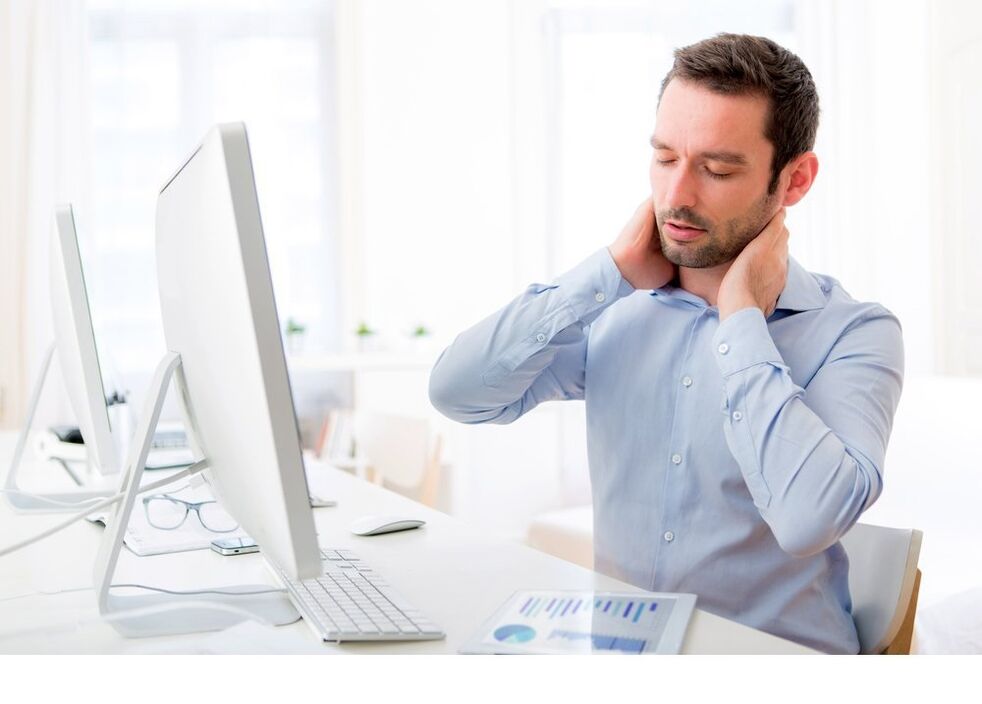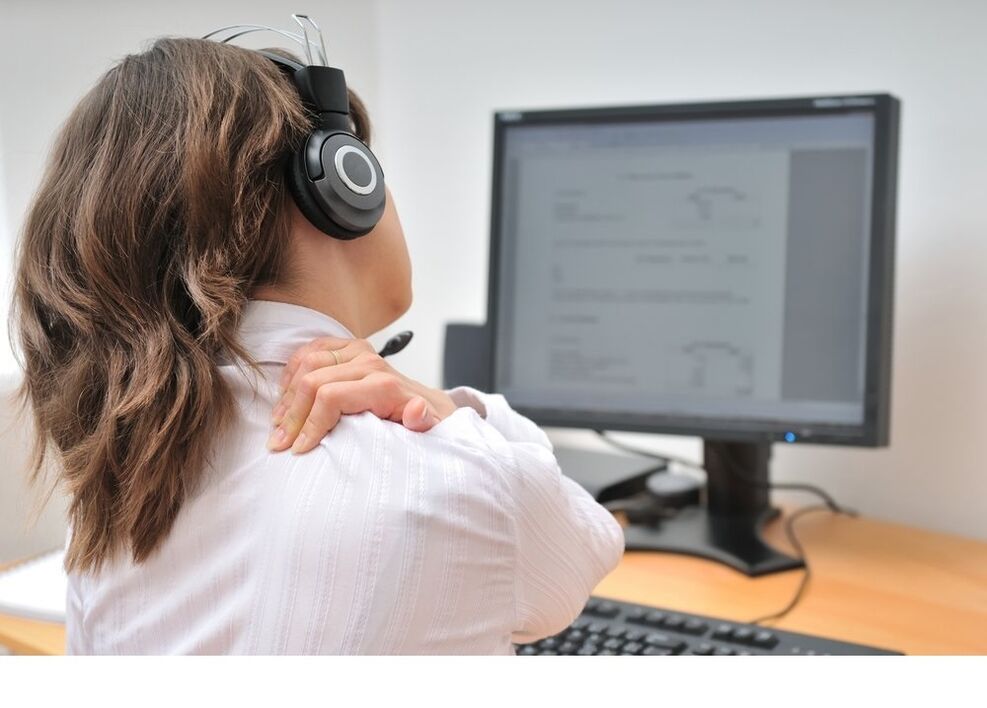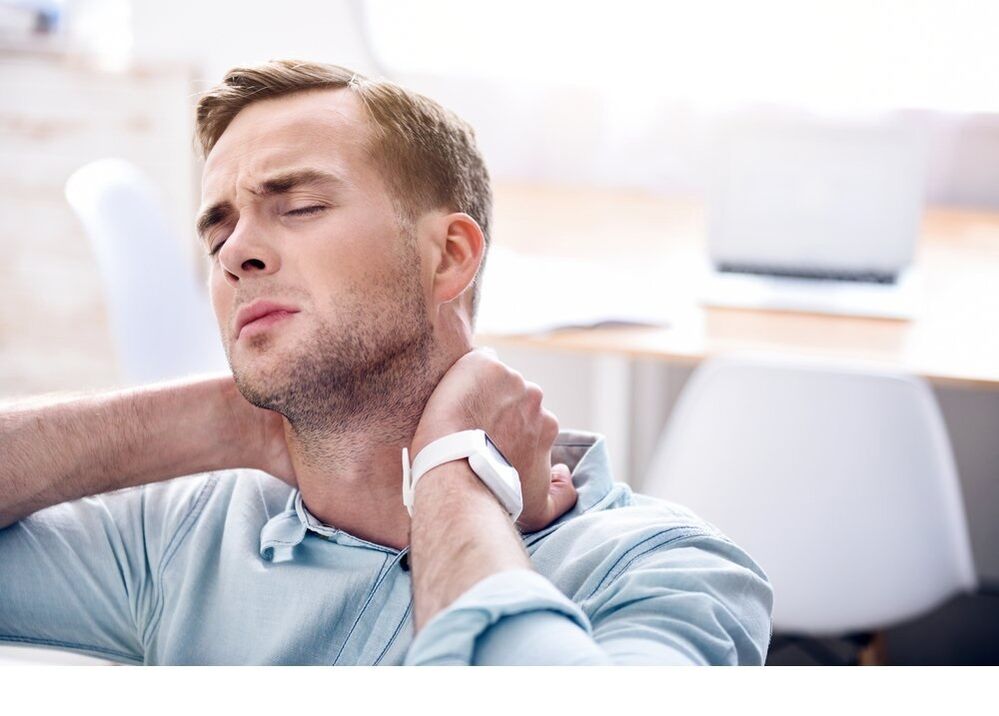The symptoms of neck pain are familiar to everyone: it pulls the muscles, it is impossible to bend and turn your head, you need to turn your whole body to look to the side. The culprit of difficulties, as a rule, is the spine: disorders, hernias, scoliosis, cause a person to experience back and neck pain. Anxiety forces him to treat himself. However, if the neck pain does not go away after home treatment, the next step is to see a doctor.
Neck pain in adults
Neck pain in women

Neck pain during pregnancy
Back and neck pain often worries expectant mothers. The explanation is simple - with a change in body weight and proportions, posture changes, the load on the spine increases.
How can this problem be overcome? A special maternity bandage will help keep your back in the right position. It is useful to do swimming and yoga to strengthen the back and neck muscles (of course, with the permission of a midwife). You need to sleep in a comfortable position, on a firm mattress and a low pillow. But the most important thing is to see a doctor, because any self-medication can adversely affect the condition of the mother and the unborn baby.
Neck pain in young mothers
Back and neck pain are common among young mothers. The problem is complicated by the fact that a woman can not use many drugs while breastfeeding, because harmful substances will enter the milk. How can you help yourself and prevent the pain in the neck from interfering with the baby's joy?
- Follow your posture. When carrying a baby, the center of gravity changed with the increase in the abdomen - you had to bend back to maintain balance, and your shoulders were always tense.
- Do not overload physically, try to properly distribute the load on the back. Various carriers can help. They distribute the child's weight on both shoulders and prevent back and neck fatigue.
- Baby care items should be adjusted to their height so that they do not stand in an uncomfortable position for a long time.
- It is very important to be in a comfortable position, especially when breastfeeding at night.
Neck pain in men

Neck pain, as a rule, does not differ by sex - it can be seen in both men and women. There are some differences in anatomy: the man's neck is decorated with an open Adam's apple - a thickening of the thyroid cartilage, the plates of which are at an angle to each other.
Adam's apple pain in men can indicate a very serious disease:
- Thyroiditis is an inflammation of the thyroid gland. Patients with thyroiditis are concerned about neck pain when turning, Adam's apple, pain above and below, swelling in the neck.
- Thyroid cartilage cancer - its danger is that the onset of the disease may resemble a common cold: sore throat when swallowing, difficulty turning the neck and even breathing.
- Thyroid cartilage phlegmon is a life-threatening condition of the cartilage and soft tissues of the neck. Patients suffer from tremors and high fever, pain when swallowing, loss of voice, difficulty breathing.
- Cartilage tuberculosis, as a rule, occurs with existing pulmonary tuberculosis and is a complication of it.
- Kadik may be ill due to osteochondrosis. Violation of the law causes pain when swallowing, sneezing, coughing.
- Cartilage fractures, bruises, and compression can cause dislocation, neck swelling, and suffocation.
Neck pain in the elderly
Pain in the neck may indicate the development of disease in the elderly:
- Lung apex cancer (cancer with Pancost and Horner syndrome). In this case, the patient's pain is associated with the tumor growing to the nerve endings of the shoulder girdle and neck.
- Tumors of the neck, salivary glands.
- Coronary heart disease. The pain can spread from the chest to the neck and arms, causing symptoms similar to osteochondrosis.
- Polymyalgia rheumatism is an inflammatory disease characterized by stiffness and pain in the muscles of the shoulder girdle and hip.
- Spinal metastases in various oncological diseases (it is no secret that the risk of cancer increases with age).
- Subluxation of the cervical vertebra as a complication of rheumatoid arthritis.
- The most common causes of neck and neck pain in the elderly are lumbar osteoarthritis and osteochondrosis, rheumatoid arthritis and chronic inflammation of the connective tissue.
Neck pain in children

Severe neck pain in children has the same causes as in adults:
- Trauma
- Osteochondrosis
- Stress and anxiety
- Tumors
- Diseases of other organs that cause distant pain
The most specific "uterine" cause of neck pain is torticollis when the child's head turns sharply to the side. Torticollis is dangerous because it causes curvature of the cervical spine and disrupts the formation of the facial skeleton.
Contrary to popular belief, the disease is not limited to childbirth. The following types differ depending on what torticollis looks like:
- Congenital - Improper placement of the fetus can occur in the womb, but most often occurs at birth, when the baby turns its head to the side and injures the neck muscles.
- Dermatogenous - when the neck is twisted from scars from trauma or burns.
- Reflex - occurs with injuries, otitis media, diseases of the salivary glands.
- Neurogenic - due to muscle spasms after polio or encephalitis.
- Spastic - due to excessive tension of the cervical muscles.
- Traumatic - associated with a spinal fracture.
Torticollis (excluding dermatogens and neurogens) is generally observed in newborns or manifests itself in the first months. The greatest risk of its occurrence occurs in the following cases:
- The fetus, which is born naturally, is presented in the form of a nipple.
- The place where the fetus is in the mother's womb is when it presses against the wall of the uterus.
- Childbirth is difficult and the baby's mastoid muscle is damaged (with the formation of ulcers).
- For hard work it is necessary to use forceps and vacuum.
- During intrauterine development, the mastoid muscle becomes inflamed, as a result of which the muscle tissue is replaced by fibrous tissue in the area of inflammation.
- The mastoid muscle is pathologically hypertrophied and shortened.
- By cesarean section.
How can you treat torticollis?
- With the help of conservative methods, a course of massage and physiotherapy, a special orthopedic style of the baby's head, wearing an orthopedic collar and gymnastic exercises.
- The operation is performed when conservative methods do not work. During the operation, the surgeon stretches the sternocleidomastoid muscle and corrects the child's head position.
Different types of neck pain
Acute neck pain

Why is there a sharp pain in the neck? There are two reasons:
- Trauma (fracture, shock, contusion).
- Disorders of nerve endings - this is osteochondrosis, herniated intervertebral discs, compression of the spinal canal.
Treatment of pain depends on the cause and includes:
- Prescribing pain medications.
- Muscle relaxants and antispasmodics to relieve muscle spasm.
- Cervical spine immobilization (immobilization).
- Physiotherapy and exercise therapy.
Severe neck pain
Severe neck pain is always unpleasant. I would like to quickly understand why you are in pain and get well. What are the causes of severe pain?
- Exacerbation of osteochondrosis when unsuccessful movement, rotation or concussion of the body causes displacement of the vertebrae, disruption of the existing hernia, compression of the spinal nerves.
- Cervical radiculitis (inflammation and compression of the spinal cord).
- Cervicago - "lumbago" (acute severe muscle spasm).
- Severe back and neck pain can occur after an injury.
Neck pain with osteochondrosis
Neck pain with osteochondrosis is very severe and gives the patient very unpleasant moments. As a result of muscle spasms or displacement of the vertebrae relative to each other, the arteries that supply the brain can be squeezed or twisted. In the most severe cases, this can lead to a similar situation before a stroke, when a person is dizzy, everything floats in front of his eyes, and sometimes he loses the ability to speak and see.
Neck pain on the left

Neck pain on the left side is a possible sign of problems not only in the cervical spine, but also outside. What can happen if a person has neck pain on the left side?
- Heart disease (heart attack, coronary artery disease, angina pectoris).
- Left upper lung cancer.
- Injuries.
- Metastases of tumors from other organs to the nodes on the left side of the neck.
- Infectious inflammation of the lymph nodes (due to tonsillitis, ARVI, tonsillitis).
Neck pain on the right
Neck pain on the right side is an alarming symptom, but in most cases it is explained in an unusual way: a person has osteochondrosis, along with all the subsequent consequences. Such outcomes include nerve compression, muscle spasms, intervertebral disc herniation, and hernias and vascular disease.
But there are other causes of right neck pain:
- Biliary colic spreads to the neck and shoulders.
- Lung cancer Right-sided apical lung cancer with tumor invasion of the nerves located above.
- Bruises, injuries, fractures of the clavicle and vertebrae.
- Cervical spine tumors (metastases from other organs).
- If the pain is concentrated in the right front of the neck, it may indicate heart problems (heart attack, coronary artery disease).
- Inflammation of the lymph nodes due to ARVI and sore throat.
Neck and shoulder pain

Pain in the neck and shoulders is a classic symptom of cervical osteochondrosis and its associated complications (hernia, nerve, spinal cord damage). In addition, simultaneous pain in the neck and shoulders is a sign of such diseases:
- Gallstone disease during exacerbation of biliary colic.
- Heart disease.
- Osteoarthritis of the shoulder.
- Cervical plexitis is an inflammation of the large nerve nodes of the spinal nerves.
- Periarthritis of the shoulder and scapula - inflammation of the shoulder tendons and capsules of the shoulder joints.
- Myositis.
- Arthritis.
Neck and back pain
Pain in the neck and lower back is usually a sign of widespread osteochondrosis, which affects the entire spine. It does not happen that the posture is good in one part of the waist and bad in the other. In osteochondrosis, neck pain is mild during remission, and if it worsens, it is strong and painful. Exacerbation begins with a failed turn, movement, blow with sharp pain in the neck and back. Medications prescribed by a doctor can be removed with the help of rest, light heat in the affected area, exercise therapy and physiotherapy.
Neck and neck pain
Pain in the neck and back of the head is the most common symptom of cervical osteochondrosis - a dangerous disease, but not fatal. However, it sometimes causes meningitis, which is life-threatening. The causative agents of meningitis - bacteria and viruses - penetrate the brain and spinal cord and cause inflammation of their membranes.
Numbness, pain in the neck and back of the head, stiffness of the occipital muscles, as well as the inability to pull the head to the chest, bending the leg at the knee - all these are meningeal symptoms that will immediately inform the doctor. Treatment of a dangerous disease is carried out in a hospital,
In addition to meningitis and osteochondrosis, pain in the neck and back of the head can be caused by injuries, neuralgia of the occipital nerve, hypertension, and muscle tension.
Causes and symptoms of neck pain
Trauma

The cause of neck pain is sometimes dislocation or fracture of the cervical vertebrae, resulting in injury to the spinal nerves. Injury can occur as a result of an accident, fall, injury, poor diving or sudden movement. Symptoms of a neck injury include:
- Improper neck flexion, inability to tense the head, chest and neck muscles indicate a fracture of the lower vertebrae.
- Pain in the crown and back of the head is an indication of damage to the 1st cervical vertebra.
- Swelling and "bruising" can be the result of a neck injury.
- Painful headaches when turning the head, on the shoulders, in the upper part of the chest, are a sign of whiplash injury caused by sharp bending and elongation of the neck (this can occur when the car is braked suddenly).
Neoplasms

An extremely dangerous cause of neck pain is a malignant neoplasm. How can that be?
- Neck pain as a sign of a tumor in the upper part of the lungs. Nerve bundles and blood vessels sprout, causing severe pain. Depending on the location of the tumor, neck pain on the left or right side may bother a person.
- Symptoms of neck pain sometimes indicate the development of lymphoma - cancer of the lymph nodes. Because many lymph nodes are concentrated on the neck, they grow with the progression of the disease and are difficult to spot. Other notable symptoms of lymphoma include excessive sweating, unexplained fever, and weight loss.
- Salivary gland cancer is a tumor that affects the salivary glands behind the ears, on the side of the neck, and on the palate. It is painless in the early stages, you can only occasionally see seals on the affected glands.
- A tumor of the larynx grows on the walls, visually representing a nodular neoplasm. They are difficult to distinguish during routine examination, so cancer is unfortunately diagnosed at a late stage when other manifestations appear: a feeling of a foreign body in the throat, darkening of the voice and runny nose, difficulty breathing. Tumors of the larynx are also dangerous because they are prone to the early appearance of metastases, which significantly worsens the patient's prognosis.
- Thyroid cancer manifests itself with nodular lumps, pain in the front of the neck and changes in voice.
- Patients with thyroid cartilage cancer have difficulty swallowing and moving food in the larynx, feel a foreign body, or feel a lump in the throat.
Pain in diseases of other organs
Pain in the neck does not always indicate that the problem is in the neck. Sometimes it hurts due to poor health of other organs, and then the pain is reflected. What diseases can cause it?
- Heart (ischemic heart disease, heart attack, angina pectoris) - is accompanied by attacks when the pain spreads to the shoulders, neck, and sometimes to the arms.
- Pain in the right side of the gallbladder, under the right scapula, and in the right shoulder occurs during an attack of gallstones with gallstones.
- Esophageal diseases (reflux, erosion, ulcers).
- Oncological diseases (lymphoma, tumor metastases) are the cause of human suffering when the neoplasm affects the nerve endings. Thus, apex cancer of the lung causes pain in the neck and shoulders when the tumor grows upwards. Intracranial tumors and head oncological diseases also cause pain in the neck and back.
- Head abscess and phlegmon.
- Bleeding into the subarachnoid space between the brain and its delicate tissues.
Psychological causes of neck pain
Symptoms of neck pain often occur with muscle spasms. Spasms are not just due to stress, injury or trauma - they can be caused by stress, nervous shock and fatigue. Why does this happen?
The fact is that the body perceives stress as a threat to well-being, and this moves it. There is a release of stress hormones into the bloodstream, the pulse increases and digestion slows down. Muscle tone increases in response to hormonal changes. As soon as an alarming situation occurs, the body returns to normal. However, if the emotional stress takes a chronic form, the muscle spasm stabilizes and against its background develops back diseases (osteochondrosis, hernia, disc herniation).
Sedentary lifestyle, frequent computer work

Pain in the muscles of the neck is often caused by a person's impaired posture, and the cause of the impaired posture may be the weakness of the muscle corset. As a rule, this happens to people who are away from physical education, lead a sedentary lifestyle and work a lot on the computer. The situation is aggravated by the fact that the workplace is often not properly organized and the person is sitting in a bent position or bent in an uncomfortable position. As a result, neck pain becomes a constant companion, normal muscle spasms occur, degenerative changes in the intervertebral discs begin, and osteochondrosis develops. Even with osteochondrosis, neck pain is a constant companion: periods of reduced pain are replaced by exacerbations, and only competent treatment, sedentary lifestyle, posture control, strengthening of the neck and lumbar muscles can disrupt this cycle. .
Diagnosis for neck pain
How to determine the causes of neck pain and make a diagnosis?
- First you need to collect a medical history:
- Life history. It is necessary to find out whether there have been injuries to the neck and shoulder girdle in the past, what diseases a person suffers from and which ones have become chronic, and whether there have been recent colds and hypothermia. For example, the fact of cholecystitis can explain the painful sensations in the neck - pain with bile colic sometimes spreads only to this area. It can also cause left neck pain: swelling in the upper part of the left lung, muscle inflammation and compression of the left spinal cord.
- History of the disease - how and how it started, which doctor the patient went to, what examination and treatment was prescribed for him, how it affected the course of the disease (better or worse).
- Visual examination will help to make a diagnosis - the doctor palpates the lymph nodes and muscles, checks the mobility of the head and neck, assesses the condition and color of the skin, looks for visible injuries and traumas.
- If there is a suspicion that neck and shoulder pain is the result of diseases of other organs, the patient should consult a specialist - oncologist, endocrinologist, gastroenterologist, cardiologist, etc.
- In other cases, radiation diagnostics will help clarify the diagnosis: MSCT, CT, X-ray.
- Electroneuromyography (ENMG), sometimes an electrophysiological study, is a useful diagnostic procedure that determines the condition of muscles and the peripheral nervous system.
Treatment of neck pain
Drug treatment

Medical treatment for neck pain, if it is caused by cancer or other organ problems, aims to cope with the identified underlying disease. If the problem is in diseases of the spine and muscles, the following drugs can be prescribed:
- Nonsteroidal anti-inflammatory drugs (NSAIDs) are used to relieve pain and reduce inflammation. NSAIDs are available as tablets, injections, and gels and ointments. In the acute phase, both can be prescribed (at intervals of several hours). So, if you can turn your head from neck pain only with tears, needles and ointments will help.
- Muscle relaxants are drugs that reduce skeletal muscle tone.
- Antispasmodics - drugs that relieve smooth muscle spasms.
- B vitamins are needed to improve metabolic processes and the synthesis of neurotransmitters.
- If blood circulation is impaired due to constriction of blood vessels and muscles, vasodilators are prescribed.
Massage
Massage is used to treat pain in the neck and back when the acute symptoms of the disease disappear. The beneficial effects of massage are:
- Improves blood flow to the affected area
- Eliminates muscle spasms, relaxes, helps relieve tension & fatigue
- Eliminates swelling & inflammation
- Improves blood supply to the brain
- Restores the mobility of joints
Physiotherapy
Physiotherapy treatment for neck pain begins at the same time as medication when acute symptoms subside or remission occurs. Only analgesic manipulations can be prescribed during the acute course of the disease. Physiotherapy has a good effect, because the effect is especially focused on the diseased area. What procedures are possible?
- Electrophoresis with various drugs. Under the influence of alternating current, the drug penetrates deep into the tissues.
- Phototherapy (laser therapy) - exposure to light rays of a fixed wavelength in the affected area of the body.
- Magnetotherapy is a method of treating pain in the lower back and neck using a variable or permanent magnetic field. The method has anti-inflammatory and analgesic effects.
- Ultrasound treatment allows you to get rid of neck pain and inflammation.
- Detensor therapy is the stretching of the spine due to the weight of a person on a special mattress with inclined ribs. This type of physiotherapy normalizes muscle tone and relieves tension.
- The shock wave therapy (SWT) method is based on the effect of low-frequency acoustic waves that the human ear cannot hear. Treatment with shock wave therapy allows you to reduce or eliminate pain, improve blood flow in the area of exposure to the device.
- Vibration therapy - exposure to mechanical vibrations using vibrating massagers.
- Exercise therapy (physiotherapy exercises) - a complex, ranging from traditional gymnastics to a set of individual exercises, prepared taking into account the diagnosis and condition of the patient.
Surgical intervention
Surgical treatment for neck pain is prescribed when conservative treatment does not give the desired result:
- The drug does not go with the medication
- There are signs of compression of the spinal cord and roots
- Weakness and growth in the muscles of the hands
Surgery to remove disc herniations is often performed simultaneously with the fusion and immobilization of adjacent vertebrae. Laminectomy is used to remove compression of the spinal cord - removal of part of the spinal arch, followed by removal of osteophytes and hernias.
After surgery and proper rehabilitation, the symptoms of neck pain stop bothering the patient.
Prevention of neck pain

With neck pain, turning your head, bending or lying down comfortably becomes a big problem. And if it hurts too much, life will not be pleasant. By preventing it, you can prevent neck problems. What should we do?
- Choose a comfortable sleeping position, a mattress that is strong enough and a low pillow that will not fall on your shoulders.
- Follow your posture: do not bend, do not sit in a bent position.
- Do at least simple exercises to strengthen your neck muscles on a regular basis. Helps with stretching and yoga.
- If you have a sedentary lifestyle, take a break every half hour to walk, lie down and lie down.
- Protect yourself from physical injuries: do not turn your neck sharply, avoid blows and traumatic sports loads.
- Get rid of the habit of listening to the phone and pressing your shoulder.
- Avoid nervousness, stress and anxiety. Negative emotions and anxiety can cause stiffness, fatigue and muscle cramps.
- Spinal distortion It is undesirable to load one of the two shoulders because the neck pain is on the right or left.
- Avoid colds and drafts that can cause myositis (inflammation of the neck muscles).
- Drink plenty of decaffeinated liquids. Adequate water allows your muscles to efficiently transport the substances and electrolytes they need.
- Eat foods that contain calcium, magnesium, sodium and potassium. Lack of these substances can cause muscle spasms and neck pain.
Severe neck pain can seriously ruin your life, especially if it occurs at the wrong time - for example, on a long-awaited vacation. Therefore, in the first "calls" you should ignore the body's alarms, be examined and seek medical advice. It is worth remembering about prevention: moderate exercise, sleep and work in a comfortable position, proper nutrition and weight distribution during transportation will help maintain neck health.













































